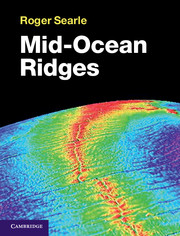Book contents
- Frontmatter
- Dedication
- Contents
- Preface
- 1 Introduction
- 2 Techniques of MOR study: a brief historical review
- 3 The oceanic lithosphere
- 4 Ridges as plate boundaries
- 5 Crustal structure and composition
- 6 Volcanism
- 7 Tectonism
- 8 Hydrothermal processes
- 9 Summary and synthesis
- Appendix A Glossary of terms
- Appendix B Directory of named features
- References
- Index
- Plate Section
2 - Techniques of MOR study: a brief historical review
Published online by Cambridge University Press: 05 June 2014
- Frontmatter
- Dedication
- Contents
- Preface
- 1 Introduction
- 2 Techniques of MOR study: a brief historical review
- 3 The oceanic lithosphere
- 4 Ridges as plate boundaries
- 5 Crustal structure and composition
- 6 Volcanism
- 7 Tectonism
- 8 Hydrothermal processes
- 9 Summary and synthesis
- Appendix A Glossary of terms
- Appendix B Directory of named features
- References
- Index
- Plate Section
Summary
Introduction
Like most sciences, the history of MOR studies is closely linked to advances in technology, ranging from the lead-weighted sounding line in the nineteenth century to modern, autonomous robotic instruments. A detailed account of most current geophysical surveying techniques is given by Jones (1999).
Depth measurement
A fundamental measurement is the ocean depth, which yields vital information on the structure of the sea floor and the processes that shape it.
Line and weight sounding
Initial attempts to measure full ocean depth using the ‘lead lines’ employed for navigating shallow waters proved inaccurate, until Maury (1860) made a systematic study to improve such soundings, for example by measuring the speed of fall of the weight to judge when it reached the bottom. These methodswere rapidly adopted by other navies.William Thomson (Lord Kelvin) improved the sounding line method by replacing hemp line by steel piano wire in 1870 (Shepard, 1959). This was trialled on the Challenger expedition (1872–1876) and was used on the contemporaneous USS Tuscarora expedition (Murray and Hjort, 1912). Kelvin introduced his ‘Sounding Machine’ in 1878, using a hand-operated, and later mechanised, winch (Figure 2.1).
- Type
- Chapter
- Information
- Mid-Ocean Ridges , pp. 11 - 43Publisher: Cambridge University PressPrint publication year: 2013



